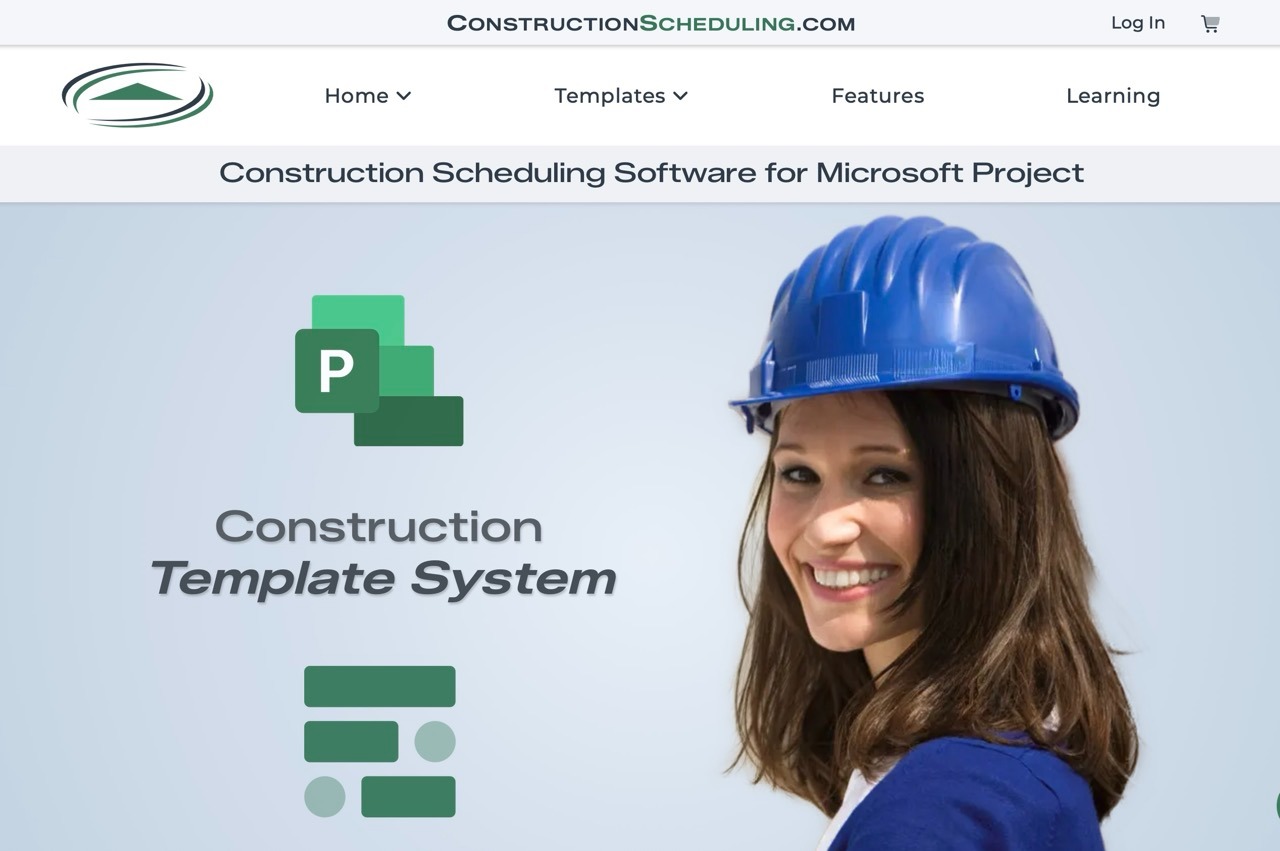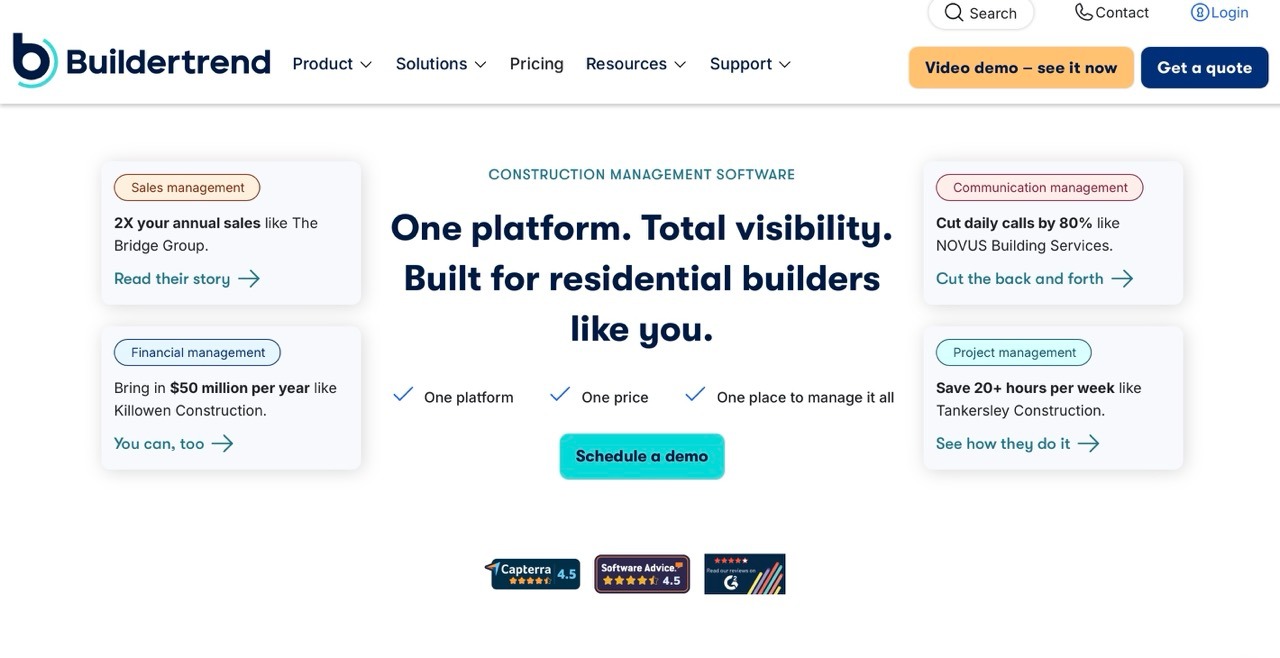50 Best Construction Scheduling Software Platforms in 2025

The global construction software market was valued at about $8.87 billion in 2024 and is expected to reach $21 billion by 2032.
Anyone who’s managed a construction project knows how quickly plans can shift. Labor shortages, supply chain delays, and tighter deadlines make it harder than ever to keep projects on track. That’s why more teams are moving away from spreadsheets and manual scheduling toward smarter, automated solutions.
Modern construction project scheduling software helps teams stay organized, adapt to changes in real time, and collaborate easily across the office and the field. With so many platforms available, finding the best scheduling software for construction can be challenging. Some are built for small contractors, while others suit large commercial operations.
In this guide, we review 50 leading platforms, comparing their features, pricing, and user feedback to help you choose the best fit for your business.
Comparison Table: Top 50 Top Construction Dispatch and Scheduling Tools of 2025
Deep Dive: Top 5 Most Trusted Construction Scheduling Solutions
Although all 50 platforms in our comparison provide useful scheduling features, we’ve highlighted five that consistently receive high user ratings and have proven performance in a variety of construction settings.
1. Planera

- Location: United States
- Company Size: 50-200 employees
- Founded: 2016
- Starting Price: Custom pricing for users
Planera is recognized in the construction software market for offering an intuitive interface alongside robust scheduling features. It was launched in 2016 by industry experts who thought that existing tools were overly complex. So the platform has been developed by addressing actual user needs and incorporating feedback.
Planera’s Construction Scheduling Expertise
Planera’s key advantage is combining functionality with ease of use. It supports multiple scheduling approaches, such as Gantt charts and Kanban boards. This allows teams to plan projects in a way that matches their workflow.
Key features:
- Collaborate on Whiteboard
Work together with your entire team on the same project in real time. Just like Google Docs, everyone can edit, draw, and add input on a shared whiteboard without waiting for updates or file exchanges. - Project Dashboard
Keep track of everything in one place. The dashboard gives you a quick overview of important project metrics, helping teams stay aligned on progress, deadlines, and priorities. - DCMA Quality Check
Easily manage schedules, scoring, and grading all in one view. This tool helps identify areas that need improvement right on the table or canvas, so teams can act fast and stay compliant. - Field Schedule (New Feature)
Create a working schedule from the master plan in under 30 seconds. This feature makes it simple to break down complex project timelines into smaller, actionable field tasks. - Data Center Management
Get real-time progress updates on data center projects, monitor risks, and manage multiple stakeholders efficiently. Integrated scheduling tools and dedicated support help keep even the most complex builds under control. - Enterprise Insights
Access enterprise-wide visibility into project performance. The platform connects data across teams, giving leaders real-time insights to make faster, more informed decisions.
Planera runs on secure cloud infrastructure, which ensures reliability and easy access across devices. It’s used by contractors of all sizes, from small builders to large commercial firms.
Planera Portfolio
AMLI tested Planera on a 310-unit development in Colorado and quickly saw faster scheduling, smoother team communication, and stronger field adoption. With real-time visibility in the cloud, collaboration improved across all roles, leading AMLI to replace MS Project entirely and cut down on costly schedule delays.
2. Workyard

- Location: United States
- Company Size: 200-500 employees
- Founded: 2018
- Starting Price: $6/user/month + $50 company base fee (Starter)
Workyard entered the construction software market to serve field contractors and smaller construction firms that need simple, reliable scheduling paired with accurate time tracking and GPS data. It focuses on the real connection between workforce management and scheduling, which helps contractors see where crews are, how long tasks take, and how efficiently work gets done.
The platform has become popular with companies that find large enterprise tools too complex or costly. With affordable pricing and practical features, Workyard fills a gap for teams with 5–50 employees who want better control over projects and labor costs.
Workyard’s Construction Scheduling Expertise
Workyard combines scheduling, GPS-based time tracking, and job verification in one system. Managers can build and adjust schedules easily, while the software automatically logs when employees arrive at or leave job sites. This ensures payroll accuracy and provides visibility into real progress.
Key features:
- GPS time tracking and verified clock-ins
- Drag-and-drop scheduling and dispatch tools
- Instant updates to field teams through mobile notifications
- Overtime alerts to manage labor costs
- Integration with accounting and payroll systems
- On-site photo documentation
- Performance reports showing task duration trends
Workyard works well for contractors in residential, commercial, and specialty trades, as well as service-based construction companies. Its strength lies in merging scheduling, tracking, and communication into one easy-to-use workflow.
Workyard Portfolio
Workyard is used by thousands of small and mid-sized contractors, including electricians, plumbers, HVAC installers, and maintenance firms.
One electrical contractor with 25 employees cut labor costs significantly after adopting Workyard. GPS tracking revealed lost time from long breaks and inefficient routes, saving hours per week and thousands in payroll each month. Dispatchers also gained real-time crew visibility, improving scheduling accuracy and customer response times.
Another remodeling company used Workyard’s reporting to spot which tasks were taking longer than expected. With better data, they improved their estimating process and increased project profit margins from 14% to 21% within eight months.
3. ConstructionScheduling

- Location: United States
- Company Size: 10-50 employees
- Founded: 2012
- Starting Price: Complete Template Bundle at $345.00
ConstructionScheduling is designed specifically for creating and managing project schedules, rather than serving as a full project management suite. This focus lets it offer advanced scheduling features at an affordable price, especially for companies that already use separate accounting or document management systems.
The platform fits into contractors’ existing workflows and provides professional scheduling tools that integrate with other systems while keeping setup and use straightforward.
ConstructionScheduling’s Construction Scheduling Expertise
The platform excels at creating detailed schedules for complex projects. It supports critical path method analysis, scenario planning, and collaborative schedule development, allowing project managers, subcontractors, and clients to contribute without causing version conflicts.
Key capabilities:
- CPM scheduling with task dependencies and critical path tracking
- What-if scenario modeling for testing plan changes
- Collaborative schedule editing for subcontractors and partners
- Baseline schedule preservation to track changes
- Export options to PDF, Excel, and compatible formats
- Resource loading and leveling to prevent overbooking
- Schedule variance analysis for tasks ahead or behind
- Look-ahead views for upcoming work in weekly or bi-weekly windows
ConstructionScheduling serves general contractors, construction managers, subcontractors, and owner representatives. Its unlimited user pricing is ideal for sharing schedules with large teams and multiple subcontractors.
ConstructionScheduling Portfolio
ConstructionScheduling supports a wide range of clients from small specialty contractors to mid-sized general contractors managing projects up to $50 million.
One general contractor using ConstructionScheduling replaced fragmented schedules in Microsoft Project and Excel with a single source of truth. Unlimited subcontractor access allowed teams to flag conflicts early, reducing schedule-related RFIs and delays by 58 percent. Another construction management firm used the platform’s scenario modeling to advise clients on schedule risks and trade-offs, strengthening client relationships and securing contract expansions.
4. SmartPM

- Location: United States
- Company Size: 50-200 employees
- Founded: 2017
- Starting Price: Custom Pricing
SmartPM focuses on schedule analysis, delay documentation, and change order support rather than daily schedule creation. The platform is designed for contractors and project managers who need deeper insights into project performance and schedule impacts.
Founded by construction professionals and attorneys, SmartPM automates much of the complex analysis traditionally done by consultants. This helps teams identify emerging issues, quantify delays, and manage change orders before problems escalate, saving both time and money.
SmartPM’s Construction Scheduling Expertise
The platform excels at analyzing schedules from tools like Primavera P6 and Microsoft Project to provide actionable insights. It highlights trends, delays, and critical path changes that might not be obvious in a Gantt chart.
Key features:
- Automated schedule health checks against best practices
- Critical path monitoring with alerts for shifts
- Delay impact analysis for change orders and disputes
- Automatic schedule narratives for reports and legal documentation
- Progress tracking and completion forecasting
- Resource and activity trend analysis for future planning
- Change order impact assessment
- Schedule version comparison
SmartPM is used primarily on medium to large commercial and infrastructure projects where schedule complexity justifies advanced analysis. It helps teams proactively identify risks and take corrective action before delays grow costly.
SmartPM Portfolio
Clients include general contractors, construction managers, and owners managing large capital projects.
One case study involved a $180 million hospital expansion. SmartPM flagged that a trade was falling behind schedule, potentially delaying completion by 47 days. The team adjusted sequencing and added crews, preventing costly liquidated damages and saving an estimated $2.8 million.
Another example is a public infrastructure portfolio where SmartPM reduced average schedule variance from 23% to 9% over two years, allowing more accurate project delivery predictions and better capital planning.
5. Buildertrend

- Location: United States
- Company Size: 500+ employees
- Founded: 2006
- Starting Price: Custom Pricing
Buildertrend is one of the top construction dispatch and scheduling tools, serving custom home builders, remodelers, and multi-family developers. The platform is purpose-built for residential workflows, offering tools to coordinate subcontractors, manage client communication, and track projects from start to finish.
Buildertrend’s Construction Scheduling Expertise
The platform covers the full residential construction lifecycle, with scheduling as a core strength. Buildertrend combines scheduling with client management, selections tracking, and documentation to keep projects on track.
Key features:
- Visual scheduling optimized for trade coordination in residential projects
- Automated schedule templates for common project types
- Integrated to-do lists and punch lists
- Client portal for timeline visibility and selections impact
- Subcontractor communication tools for availability and conflict alerts
- Daily logs and photo documentation linked to scheduled activities
- Budget and schedule integration for cost management
Buildertrend serves custom and production home builders, remodelers, multi-family developers, and specialty residential contractors. Its unique value lies in managing both construction activities and client relationships, improving efficiency and customer satisfaction.
Buildertrend Portfolio
Buildertrend supports over 100,000 residential construction companies, from small custom builders to large production firms.
One case study involves a Pacific Northwest builder managing 25-30 homes annually. Implementing Buildertrend reduced administrative work, improved subcontractor coordination, and decreased average project duration by 18 days, allowing a 20% increase in project volume without adding staff.
Another example is a high-end remodeling contractor. Using Buildertrend’s selections and schedule integration, the company managed client expectations proactively, reducing disputes and improving referrals.
How was the List of Best Construction Scheduling Software Compiled?
Building a reliable comparison of the best construction scheduling software tools takes more than listing popular names. To identify them, we analyzed both feature depth and field usability. These systems were then compared to highlight the best ones for construction companies of all sizes.
Feature Set & Capabilities
We first examined each platform’s scheduling tools, including Gantt charts, CPM support, drag-and-drop timelines, and automated updates. Also, we looked at how well the software manages labor, equipment, and materials across projects. Strong resource tracking prevents conflicts and keeps schedules realistic.
Collaboration tools were another key factor. The best construction scheduling software platforms allow multiple team members to work together in real time, share documents, and track progress without relying on separate communication apps.
Mobile use was also important, as field teams need to view and update schedules directly from job sites. We reviewed mobile apps for both usability and feature depth compared to desktop versions.
Finally, integration with other tools, such as accounting, BIM, and project management software, was critical. Smooth data exchange reduces errors and keeps workflows connected.
User Experience & Implementation
Even the best construction scheduling software of 2025 must be easy to adopt. We rated each software’s interface, learning curve, and onboarding speed. Training resources like tutorials and webinars were also considered, as they show a vendor’s commitment to customer success.
Customer support quality mattered too. We reviewed support options, response times, and technical expertise, since timely help can prevent costly delays on active projects.
Additional Considerations
We also looked at pricing structures, contract clarity, overall costs, company reputation, and focus on the construction industry. Tools made specifically for construction usually manage trade coordination, weather-related delays, and compliance better than general project management software. Choosing the right construction scheduling tools ultimately depends on your project scale and how well the platform integrates with existing systems.
Types of Construction Scheduling Software
Construction scheduling software comes in several categories, each serving different needs:
- Project Management Platforms integrate scheduling with budgeting, document management, and communication tools. They are useful for companies that want a single system for multiple functions. Examples include Procore and Buildertrend.
- Standalone Scheduling Tools focus on creating, maintaining, and analyzing schedules. They often provide advanced CPM analysis, resource optimization, and scenario modeling. These tools work well for companies that already have accounting and document systems in place.
- Enterprise Construction Management Systems serve large contractors with complex projects. They offer scalability, security, and customization but require significant investment and support.
- Field Management Solutions prioritize mobile access, real-time updates, and communication between office and field teams. Scheduling is included but secondary to execution and documentation.
- Residential vs. Commercial Platforms recognize differences in workflows. Residential software focuses on client communication, selections, and managing subcontractors, while commercial platforms handle trade coordination, regulatory compliance, and larger teams.
- Industry-Specific Solutions serve niches like heavy civil, MEP, or roofing contractors. They include features and workflows made specifically for their specialty.
Selecting the right type depends on company size, project complexity, and existing technology. Small companies often benefit from all-in-one platforms, while larger organizations may prefer specialized tools integrated across systems.
Benefits of Construction Scheduling Software
Teams that adopt the best construction scheduling software gain measurable advantages in speed, accuracy, and coordination:
- Time-Saving: Automated updates and dependency calculations reduce hours spent manually adjusting schedules.
- Template Libraries: Prebuilt schedules speed up project setup and incorporate lessons from past projects.
- Cost Control: Detect resource conflicts early, avoid idle crews, and prevent expensive delays.
- Schedule Accuracy: On-time projects improve cash flow, reduce extended costs, and prevent penalties.
- Resource Optimization: Track labor and equipment across projects to balance workloads and make strategic decisions.
- Load Leveling: Smooth resource allocation prevents overwork and downtime.
- Risk Mitigation: Critical path monitoring and schedule health checks identify potential problems early.
- Scenario Modeling: Test schedule changes or resource shifts before committing.
- Improved Communication: Shared, current schedules reduce misunderstandings among teams, subcontractors, and owners.
- Automated Notifications: Alert stakeholders about changes and deadlines without manual updates.
- Real-Time Updates & Mobile Access: Field teams update schedules instantly, ensuring accurate planning.
- Data-Driven Decisions: Historical data and analytics help estimate durations, select subcontractors, and plan future projects.
Construction Scheduling Use Cases
- Commercial Construction: Manage complex timelines, multiple trades, submittals, and regulatory requirements. Scheduling software helps create master timelines, allocate milestones, and support change orders.
- Residential Construction: Coordinate subcontractors, client selections, and project updates. Builders use scheduling tools with client portals, templates, and visualizations to manage multiple homes efficiently.
- Heavy Civil & Infrastructure: Plan equipment-intensive operations, seasonal work, and material logistics. Look-ahead planning and resource tracking improve productivity and support claims documentation.
- Specialty Contractors: MEP, concrete, or steel contractors coordinate resources and schedules while integrating with general contractor timelines. Software provides visibility and helps demonstrate reliability.
- Multi-Project Management: Companies managing dozens of projects use scheduling tools to balance workloads, allocate resources, and plan growth based on real capacity.
- Subcontractor Coordination: Shared schedules and notifications improve collaboration, reduce delays, and provide documentation for accountability.
Software Implementation Best Practices
- Needs Assessment: Identify pain points, workflow issues, and what you want the software to solve. Include input from project managers, field staff, and admins.
- Team Training: Provide comprehensive training beyond basic operation. Identify power users for advanced support. Continue training as features evolve.
- Data Migration: Focus on active projects and essential historical data. Avoid transferring unnecessary legacy information. Consider rebuilding schedules when more efficient.
- Integration Planning: Ensure connections with accounting, document management, estimating, and other tools. Plan workflows and data flow before implementation. Budget for custom integration if needed.
- Change Management: Communicate benefits clearly, address resistance, and support teams during transition. Celebrate small wins to encourage adoption.
- Ongoing Support: Schedule regular reviews, maintain vendor relationships, and invest in periodic training refreshers. Monitor software use and update configurations as your team gains experience.
Frequently Asked Questions: Construction Scheduling Software
What is construction scheduling software?
Construction scheduling software is a tool that helps contractors and project managers plan, track, and manage project timelines. It organizes tasks, assigns resources, monitors progress, and provides insights to keep projects on schedule and within budget.
What features should I look for in construction scheduling software?
Key features include task scheduling (Gantt charts, CPM), resource management, collaboration tools, mobile access, reporting and analytics, scenario planning, and integration with other construction or accounting software. Some platforms also offer client portals, time tracking, or automated notifications.
What industries benefit from construction scheduling software?
Residential construction, commercial construction, heavy civil, infrastructure, and specialty trades like MEP or concrete work all benefit. Any industry that requires coordination of multiple teams, subcontractors, and resources can improve efficiency with scheduling software.
How do I choose the right construction scheduling tools for my business?
Consider your company size, project types, workflow complexity, and existing tools. Evaluate platforms based on features, ease of use, mobile access, integration capabilities, and cost. Testing a demo or trial version helps determine which is the best construction scheduling software for your team’s goals.
What are the common challenges in implementing scheduling software?
Challenges include data migration, employee adoption, integrating with existing systems, and aligning workflows with the new software. Proper planning, training, and change management can minimize these issues.
How much does construction scheduling software cost?
Costs vary widely depending on platform type, features, and number of users. Some offer subscription-based pricing, others flat fees or enterprise licenses. Additional costs may include training, integrations, or add-on modules.
Can construction scheduling software integrate with other tools?
Yes. Many platforms integrate with accounting software, project management tools, document management systems, BIM applications, and communication platforms. Integration ensures accurate data flow and reduces manual entry.
What training is required for construction scheduling software?
Training depends on software complexity. Basic training covers navigation, schedule creation, and updating tasks. Advanced training may include resource management, scenario modeling, reporting, and integration setup. Most vendors provide tutorials, webinars, or certification programs to support implementation.
You deserve better scheduling software
Powerful can be easy. Book a demo to see how.



